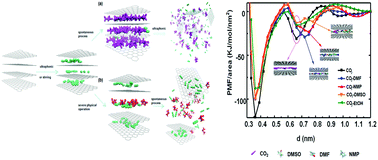当前位置:
X-MOL 学术
›
Phys. Chem. Chem. Phys.
›
论文详情
Our official English website, www.x-mol.net, welcomes your feedback! (Note: you will need to create a separate account there.)
Exfoliation and stabilization mechanism of graphene in carbon dioxide expanded organic solvents: molecular dynamics simulations.
Physical Chemistry Chemical Physics ( IF 3.3 ) Pub Date : 2020-01-06 , DOI: 10.1039/c9cp05924e Lu Cai 1 , Sensheng Hou 1 , Xiangyu Wei 1 , Guangsu Tan 1 , Zhengwei Peng 2 , Yujiao Yan 1 , Lei Wang 1 , De Lei 1 , Yanguang Wu 1 , Zhitian Liu 1
Physical Chemistry Chemical Physics ( IF 3.3 ) Pub Date : 2020-01-06 , DOI: 10.1039/c9cp05924e Lu Cai 1 , Sensheng Hou 1 , Xiangyu Wei 1 , Guangsu Tan 1 , Zhengwei Peng 2 , Yujiao Yan 1 , Lei Wang 1 , De Lei 1 , Yanguang Wu 1 , Zhitian Liu 1
Affiliation

|
CO2 expanded organic solvents possess significant advantages in liquid-phase exfoliation to obtain monolayer/few-layer graphene from graphite. Further insights into the mechanism of graphene exfoliation in such solvents are essential to explore liquid-phase dispersion of graphene as a more potent alternative to chemical vapor deposition. In this study, dynamic processes of exfoliation and stabilization of graphene in CO2-N,N-dimethylformamide (DMF), CO2-N-methylpyrrolidone (NMP), CO2-dimethyl sulfoxide (DMSO), and CO2-ethanol (EtOH) were investigated using molecular dynamics simulations. The origin of the effect of each solvent on graphene exfoliation was analyzed quantitatively through potential mean force simulations. It has been found that the organic solvent in a CO2 expanded solvent should be chosen with proper surface tension, and there exist two different graphene exfoliation processes in the effective solvents, which can be described as "burger dissociation" and "extrusion-taking away" processes, respectively. In the former process, a characteristic "super-burger-like" conformation with a semi-exfoliated structure was formed, which was the deciding factor to obtain high ratio of monolayer/few-layer graphene in dispersion product. A theoretical explanation has also been provided at the molecular level to the earlier experimental phenomena. A predicted simulation of the CO2-3,3'-iminobis(N,N-dimethylpropylamine) (DMPA) system is also calculated. This investigation helps to avoid incompatible CO2 expanded organic solvents employed in the experimental studies and provides theoretical clues to understand the mechanism of exfoliation and stabilization of graphene in such solvents.
中文翻译:

二氧化碳膨胀的有机溶剂中石墨烯的剥落和稳定机理:分子动力学模拟。
CO2膨胀的有机溶剂在液相剥离中具有显着的优势,可以从石墨中获得单层/几层石墨烯。深入了解在此类溶剂中石墨烯剥离的机理对于探索石墨烯的液相分散作为化学气相沉积的更有效替代方法至关重要。在这项研究中,研究了石墨烯在CO2-N,N-二甲基甲酰胺(DMF),CO2-N-甲基吡咯烷酮(NMP),CO2-二甲基亚砜(DMSO)和CO2-乙醇(EtOH)中的剥落和稳定过程。使用分子动力学模拟。通过潜在的平均力模拟,定量分析了每种溶剂对石墨烯剥落的影响的起因。已经发现,应选择具有适当表面张力的CO2膨胀溶剂中的有机溶剂,在有效溶剂中存在两种不同的石墨烯剥落过程,分别可称为“汉堡离解”过程和“挤出带走”过程。在前一种方法中,形成具有半剥落结构的特征性“超级汉堡状”构象,这是在分散体产品中获得高比例的单层/很少层石墨烯的决定因素。在较早的实验现象的分子水平上也提供了理论解释。还计算了CO2-3,3'-亚氨基双(N,N-二甲基丙胺)(DMPA)系统的预测模拟。
更新日期:2020-01-10
中文翻译:

二氧化碳膨胀的有机溶剂中石墨烯的剥落和稳定机理:分子动力学模拟。
CO2膨胀的有机溶剂在液相剥离中具有显着的优势,可以从石墨中获得单层/几层石墨烯。深入了解在此类溶剂中石墨烯剥离的机理对于探索石墨烯的液相分散作为化学气相沉积的更有效替代方法至关重要。在这项研究中,研究了石墨烯在CO2-N,N-二甲基甲酰胺(DMF),CO2-N-甲基吡咯烷酮(NMP),CO2-二甲基亚砜(DMSO)和CO2-乙醇(EtOH)中的剥落和稳定过程。使用分子动力学模拟。通过潜在的平均力模拟,定量分析了每种溶剂对石墨烯剥落的影响的起因。已经发现,应选择具有适当表面张力的CO2膨胀溶剂中的有机溶剂,在有效溶剂中存在两种不同的石墨烯剥落过程,分别可称为“汉堡离解”过程和“挤出带走”过程。在前一种方法中,形成具有半剥落结构的特征性“超级汉堡状”构象,这是在分散体产品中获得高比例的单层/很少层石墨烯的决定因素。在较早的实验现象的分子水平上也提供了理论解释。还计算了CO2-3,3'-亚氨基双(N,N-二甲基丙胺)(DMPA)系统的预测模拟。


























 京公网安备 11010802027423号
京公网安备 11010802027423号